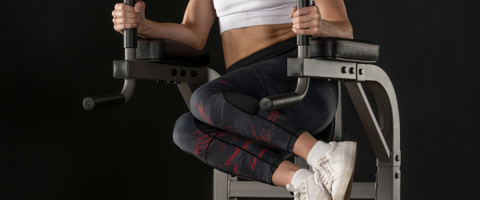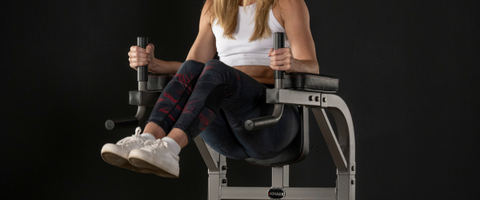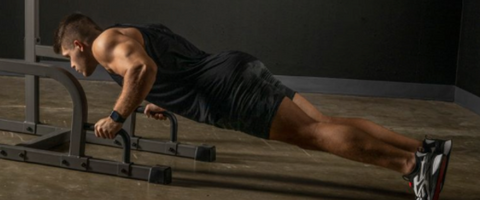Introduction to Dip Stands
Welcome to the world of dip stands. We hope you're ready to be humbled.
Dip stands target different muscle groups, including your chest, shoulders, and triceps. They come in different forms. Sometimes you will find dip stands in the form of two long parallel bars, but there are also machines that provide a more comfortable platform to do dips, core exercises, and even pullups. Think Swiss Army Knife except less portable. They offer a plethora of exercises to tone and strengthen your muscles, and we love multi-functional equipment.
In this article, we're diving deep into the world of dip stand exercises, exploring their benefits, the best moves to try, and even some home workout routines to spark some inspiration for your next lifting session.
Benefits of Dip Stand Workouts
1. Upper Body Strength
Dip stand exercises are your ticket to building serious upper body strength. They target your chest, shoulders, and triceps, often leaving you feeling like you have Jell-O for arms.
Dip stands add a spiciness to your workout that will directly target your muscular endurance (or lack thereof) in your upper body. They are a great way to benchmark your upper body strength and continuously challenge yourself to improve.
2. Core Stability

Let's talk about core stability, shall we? Your core is the foundation of your strength. And guess what? Dip stand exercises engage those core muscles like crazy. Whether you're dipping, raising your legs, or doing crunches, your core is working overtime to keep you stable and balanced.
3. Versatility
Versatility is the name of the game when it comes to dip stands. These bad boys can do it all, from dips and leg raises to push-ups and inverted rows.
And the best part? Dip stands can be adjusted to suit your fitness level and goals. Whether you're a beginner looking to dip your toes into the world of fitness (see what we did there?) or an experienced dipper ready to up the intensity of your workouts, dip stands have got your back (and your chest, shoulders, and triceps).
Best Dip Stand Exercises
1. Parallel Bar Dips
Ah, the classic parallel bar dips. It's like the bread and butter of dip stand exercises.
- Grab onto the bars with your palms facing inward and your arms fully extended.
- Lower your body by bending your elbows until your upper arms are parallel to the ground.
- Push yourself back up to the starting position and repeat.
- Is anyone else craving bread and butter now?
2. Leg Raises

Leg raises target lower abdominal muscles and overall core strength.
- Press into the dip bars with your arms fully extended and your legs straight.
- Raise your legs until they're parallel to the ground, then lower them back down with control.
- Repeat for the desired number of reps, feeling the burn with each lift.
- You can modify this set up, by starting with your forearms pressing into the arm rests (if you have that type of dip machine), instead of having straight arms. Just make sure not to collapse into your neck. You want to fight for a tall chest and engage your core so that you don't overwork your traps.
3. Push-Ups

Push-ups on dip stands? You betcha. This variation takes your standard push-up to the next level by increasing your range of motion and targeting your chest and triceps like never before.
Note: This is definitely an advanced movement and can really only be performed on long parallel bars versus an actual dip stand.
- Place your hands on the dip bars with your arms fully extended and your body in a plank position.
- Lower your chest toward the bars, then push yourself back up to the starting position.
- Repeat for the desired number of reps, feeling those muscles working with each push.
4. Triceps Dips
Triceps dips isolate and strengthen triceps muscles and will really make you resentful of gravity in general.
- Grip the dip bars with your palms facing inward and your arms fully extended.
- Lower your body by bending your elbows until your upper arms are parallel to the ground.
- Push yourself back up to the starting position and repeat for the desired number of reps.
- If you have an assisted dip stand, you can adjust the weight to make these more challenging or easier depending on your fitness level.
5. Inverted Rows
Inverted rows target your back muscles, including the lats and rhomboids. Like the pushups, this specific movement usually works best with longer parallel bars.
- Hang from the dip bars with your palms facing inward and your body in a straight line.
- Pull your chest toward the bars by bending your elbows and squeezing your shoulder blades together.
- Lower yourself back down with control and repeat for the desired number of reps.
- The closer your feet are to you, the easier this movement will be. If you really want to challenge yourself, make the angle between you and the floor narrower.
Dip Stand Workout Routines
Beginner Dip Stand Workout Routine
So you're new to the world of dip stands, huh? Don't worry, we've got you covered with this beginner-friendly workout routine:
Warm-up:
- 5-10 minutes of light cardio (e.g., jogging, jumping jacks)
- Dynamic stretches focusing on upper body mobility (e.g., arm circles, shoulder rolls)
Workout:
- Parallel Bar Dips: 3 sets of 8-10 repetitions
- Push-Ups: 3 sets of 10-12 repetitions
- Leg Raises: 3 sets of 10-12 repetitions
Cool-down:
- 5-10 minutes of light stretching focusing on upper body muscles (e.g., chest, shoulders, triceps)
Intermediate Dip Stand Workout Routine
Ready to kick things up a notch? Check out this intermediate-level workout routine:
Warm-up:
- 5-10 minutes of light cardio (e.g., jogging, jumping jacks)
- Dynamic stretches focusing on upper body mobility (e.g., arm circles, shoulder rolls)
Workout:
- Parallel Bar Dips: 4 sets of 6-8 repetitions
- Triceps Dips: 4 sets of 8-10 repetitions
- Inverted Rows: 4 sets of 8-10 repetitions
- Push-Ups: 4 sets of 10-12 repetitions
Cool-down:
- 5-10 minutes of light stretching focusing on upper body muscles (e.g., chest, shoulders, triceps)
Advanced Dip Stand Workout Routine
Feeling like a fitness god (or goddess)? Then this advanced workout routine is for you:
Warm-up:
- 5-10 minutes of light cardio (e.g., jogging, jumping jacks)
- Dynamic stretches focusing on upper body mobility (e.g., arm circles, shoulder rolls)
Workout:
- Weighted Parallel Bar Dips: 4 sets of 6-8 repetitions
- Using a belt, add a plate to weigh yourself down for an added challenge
- Triceps Dips: 4 sets of 8-10 repetitions
- Inverted Rows: 4 sets of 8-10 repetitions
- Push-Ups: 4 sets of 10-12 repetitions
- L-Sit Hold: 4 Sets holding for 30 seconds each
Cool-down:
- 5-10 minutes of light stretching focusing on upper body muscles (e.g., chest, shoulders, triceps)
Common Mistakes and How to Avoid Them
Now, let's talk about some common mistakes people make when it comes to dip stand exercises.
Improper Form: Never sacrifice form over strength. Meaning, just because you can move the weight, doesn't mean you're doing it properly. Make sure you're using proper form and technique to avoid injury and get the most out of your workouts.
Overtraining: Listen to your body. If something hurts or doesn't feel right, that is your body telling you to reevaluate. Overtraining can lead to burnout and injury, so make sure to give yourself plenty of rest and recovery time between workouts.
Neglecting Warm-Up: Don't skip the warm-up, people. It's like putting on sunscreen before hitting the beach – in the long run, you'll be happy you took the time to do it. It's essential for preventing injury and getting the most out of your workout.
Final Thoughts
And there you have it, folks – an introduction into dip stand workouts. Building strength doesn't have to be boring; it can be as dynamic and exciting as you make it. By incorporating different equipment like a dip station into your routine, you open up a world of possibilities for challenging your muscles and keeping your workouts fresh.
But it's not just about the thrill of the challenge – it's about the training results too. Dip stands offer a unique opportunity to target your core while simultaneously sculpting your upper body. With each rep, you're not just lifting weights; you're making functional, measurable strength improvements that translate into real-world performance.
Related Articles
- Gifts for Gym Lovers: Ideas for Home & Commercial Gym Goers
- Affordable Home Gym Setup: Your Budget-Friendly Guide
- Squat Rack vs. Power Rack: Which Is Right for You?

